One common problem when working with stash yarns (or any limited color palette) is what to do with that screamingly loud color that threatens to take over your piece. You know what I mean – brilliant yellow, poison green, Halloween orange – that one color that is so much brighter than the others that it sticks out like a sore thumb.
There are a couple ways to tackle these colors. One is simply to use less of them. Even the most domineering color can turn into a charming accent if used in tiny amounts, or with a draft that shows only a little bit of it on the public side of the fabric.
But what if you’re trying to use up a color – for example, if you’re weaving with stash yarns and you’re trying to use up that bright orange yarn that you “inherited” from an estate sale? That’s where color arrangement comes in. You can do a surprising amount to tone down a color just by choosing how to arrange it in your piece. Today, we’re going to talk about one of the simplest arrangements: Stripes.
Big blocks strengthen colors, small blocks weaken them
Big blocks of color – wide stripes being a great example – concentrate and intensify colors, while narrow stripes and small dots of color tend to blend with their neighbors. Consider this yellow and green log cabin design vs. the yellow and green check fabric:
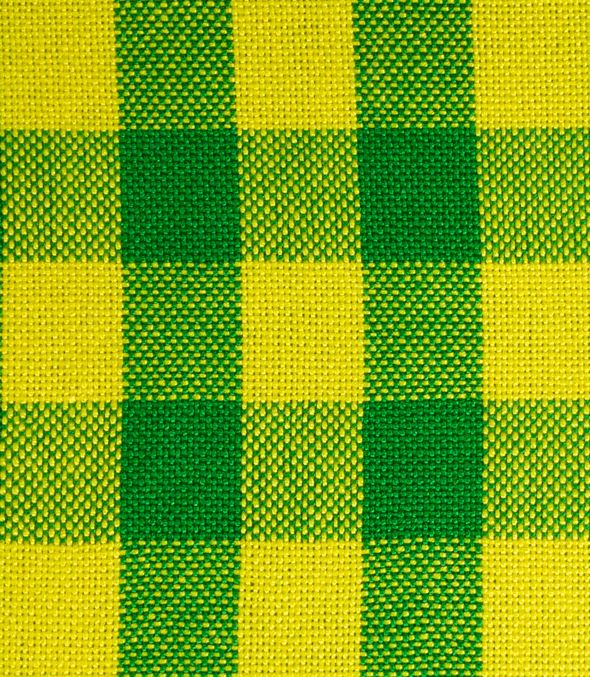
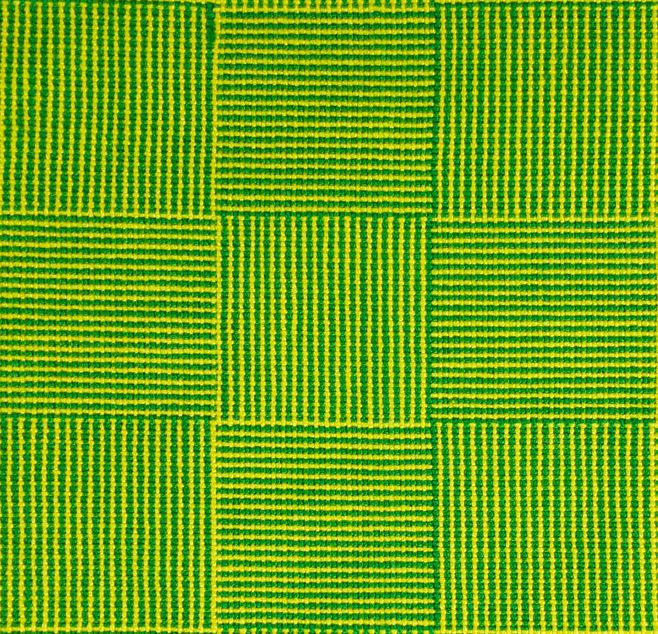
In both cases, equal amounts of yellow and green appear in the fabric, but in the first swatch, the yellow dominates the fabric, while in the second, it doesn’t.
What’s happening?
Yellow is a very dominant color, and in the checkered fabric, the big blocks of yellow concentrate its power and grab your attention. But in the log cabin fabric, the single-thread stripes diffuse yellow’s power, blending it with the neighboring green so it doesn’t grab the eye as intensely.
You can use this principle to tone down domineering colors in your piece without reducing the amount of that color in your piece. That’s great if you want to use up (finally!) that screaming orange yarn that’s been languishing in your stash for awhile.
How to prevent a domineering color from taking over
The simple principle is this: Use your domineering color in narrow stripes, and use the other colors in wide stripes. This will increase the visual impact of the other colors while diluting the impact of the dominant color, and balance the feel of the piece.
If the domineering color is truly obnoxious, try mixing it in thread-by-thread stripes with a much duller color – one that’s about the same darkness will be best – to tone it down.
An example
You can see how this works in these three swatches, all woven on the same warp with the same four weft yarns.
Here are the weft colors:
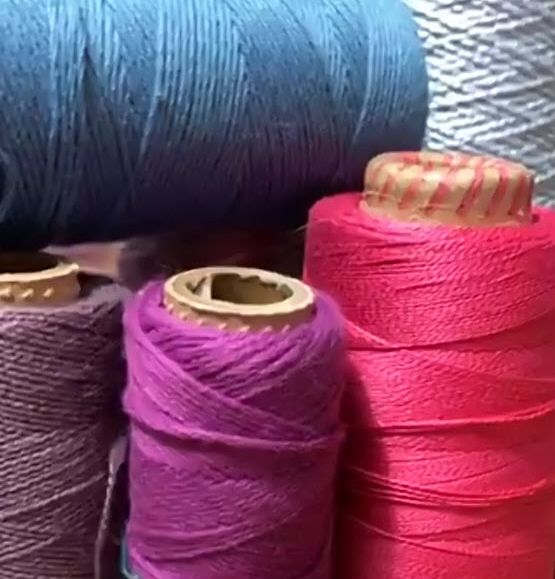
Notice how much brighter and assertive the pink is than the other colors!
When woven in stripes of equal width, the pink jumps out at you:
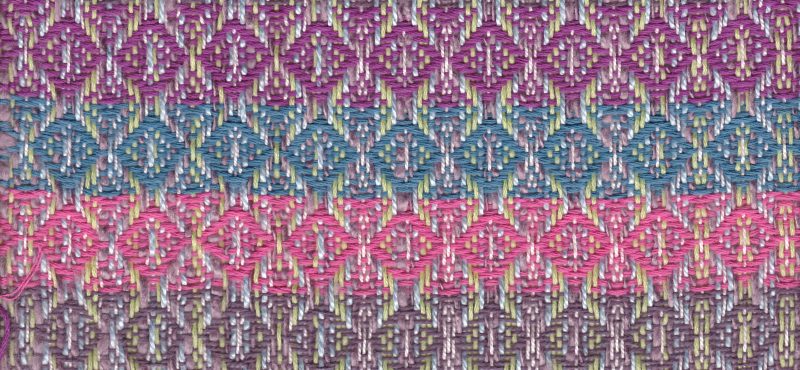
But if you break up the pink into smaller stripes, the strength of the color is diluted, and it doesn’t stand out nearly as strongly:
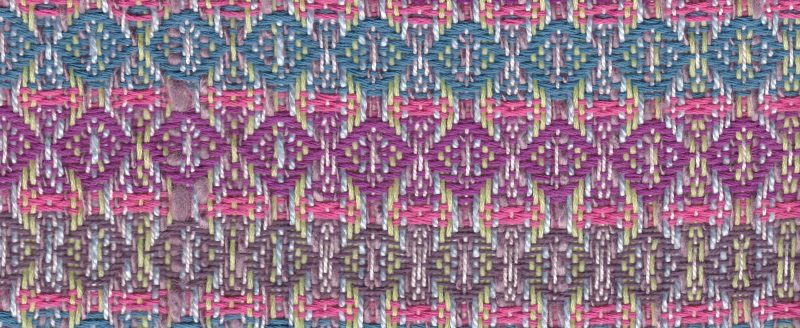
And if you break it into single-thread stripes and alternate it with the dull purple, it blends with its neighboring color, the dull purple, and becomes quite sedate:
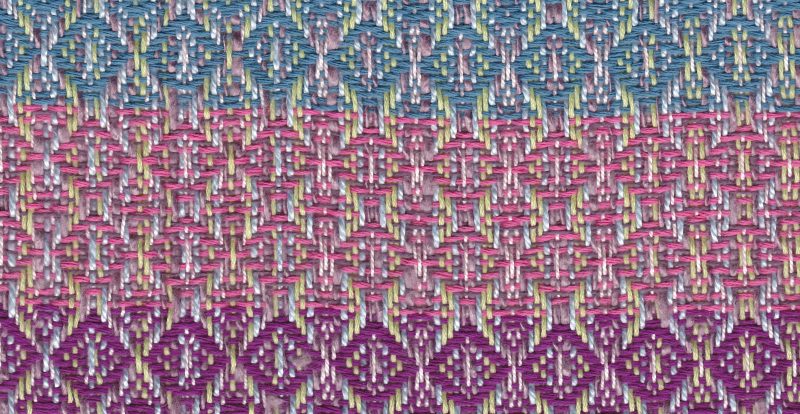
In all cases the same amount of the domineering color are being used – and just as much of it is being used as the less assertive colors! – but the impact of the color is diffused by using it in narrower and narrower stripes.
So that’s one way to use up a domineering color in your stash without having it totally take over your project: Use it in narrower stripes!
Distribute the dominant color over a larger area, rather than concentrating it in one spot. And keep the other colors concentrated in larger stripes to increase their visual impact. That will help bring color balance into your piece.
Interested in learning more tricks for weaving from your stash? This blog post is a short excerpt from our class Stash Weaving Success, which teaches you how to transform those old, tired stash yarns into beautiful new projects. This is an eight-week course that you can take in the comfort of your own home, at your own pace, with live demos and live Q&A sessions as well as prerecorded, access anytime lessons (the demos and Q&A sessions will also be recorded). This course is closed for enrollment; I am now teaching over at Handweaving Academy.

Great article. I have a screaming orange 8/2 cotton. Never opened for exactly this reason. Thankyou for another technique to add to my toolbox
Great information. Thanks Tien. I have plenty of bright colors in my stash!
Thanks….my challenge, I think, is not having, buying or using bright colors because I am also a spinner and reenactor,
so my favorite yarns are mostly natural colors and using them in historic patterns. I do like to dye using mostly
natural dyes in gradation hues to use in vertical stripes for scarves and shawls. The stash class finally forced me
to put four different colors (not natural) and different fibers together on two looms for five scarves. One a 4-H and other
an 8-H loom that I have not used in a few years. Did two samplers, one on each loom….nice differences so I put on extra
warp and had to order more weft yarn…especially a gray and a navy instead of just white and black for the wefts..
Will send some photos later. Sore new hips so I changed from a padded chair to a tilted loom bench. Much better!
Several members of my local guild are also taking the classes.
Thanks again…Susan Cayton
(online class is challenging, but also encouraging as a senior citizen slowing down.
The price for the next class is a great deal when you thing of the alternative….the cost of college credit, textbooks, travel,
food, etc.
Sincerely, Susan Cayton
Glad you’ve found the class helpful and interesting, Susan! Would love to see photos once you have them!
Dear Tien, I took your first stash class that you gave with Janet. I am also signed up for the next class. I have been wanting to convey my thanks to you for all the free information you provide the weaving community. I do know that good business policy is to give information away however, the way you do it, in my mind speaks of the quality of the person you are. You are so helpful and kind to people no matter how many times a question is asked and you explain things in different ways. I hear no judgement in your voice no mater the topic or question. I really value your qualities in a teacher. I am behind many of your students as far as knowledge and yet I feel like I can get this information and be successful eventually. At this point I am really a baby weaver.
Thank you again Tein for who you are on this planet and for being in my life (virtually).
NeeShonee
NeeShonee,
Thank you SO much for your kind words. I am so touched by them, and I am glad to have made a difference in your life. I’m looking forward to having you in my class! Students like you are why I keep teaching. (Also, I want to give you a hug!)
Tien
Awesome as ever! Thanks for posting this. Any wait for your class
los felicito por aportar con sus concimientos ya que es de gran ayuda, les doy gracias, ya que me ayuda a entender los colores y puedo tener mejor idia para hacer nuevas convinaciones
Wish I had read this article before wove last scarf in blue grey and white. White took over but if I had woven wider blue stripes would have come out how I envisaged it in my head. Know what to do now with the yellows and oranges in my stash. Thank you for the explanation.
Excellent reminder about mixing colors for a balance or going big or going home!